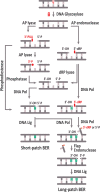DNA Base Excision Repair in Plants: An Unfolding Story With Familiar and Novel Characters
- PMID: 31543887
- PMCID: PMC6728418
- DOI: 10.3389/fpls.2019.01055
DNA Base Excision Repair in Plants: An Unfolding Story With Familiar and Novel Characters
Abstract
Base excision repair (BER) is a critical genome defense pathway that deals with a broad range of non-voluminous DNA lesions induced by endogenous or exogenous genotoxic agents. BER is a complex process initiated by the excision of the damaged base, proceeds through a sequence of reactions that generate various DNA intermediates, and culminates with restoration of the original DNA structure. BER has been extensively studied in microbial and animal systems, but knowledge in plants has lagged behind until recently. Results obtained so far indicate that plants share many BER factors with other organisms, but also possess some unique features and combinations. Plant BER plays an important role in preserving genome integrity through removal of damaged bases. However, it performs additional important functions, such as the replacement of the naturally modified base 5-methylcytosine with cytosine in a plant-specific pathway for active DNA demethylation.
Keywords: AP endonuclease; Arabidopsis; DNA damage; DNA glycosylase; DNA repair.
Figures
Similar articles
-
Single-nucleotide and long-patch base excision repair of DNA damage in plants.Plant J. 2009 Nov;60(4):716-28. doi: 10.1111/j.1365-313X.2009.03994.x. Epub 2009 Aug 8. Plant J. 2009. PMID: 19682284 Free PMC article.
-
Reading Targeted DNA Damage in the Active Demethylation Pathway: Role of Accessory Domains of Eukaryotic AP Endonucleases and Thymine-DNA Glycosylases.J Mol Biol. 2020 Mar 13;432(6):1747-1768. doi: 10.1016/j.jmb.2019.12.020. Epub 2019 Dec 20. J Mol Biol. 2020. PMID: 31866293 Review.
-
Early Steps in the DNA Base Excision Repair Pathway of a Fission Yeast Schizosaccharomyces pombe.J Nucleic Acids. 2010 Sep 16;2010:450926. doi: 10.4061/2010/450926. J Nucleic Acids. 2010. PMID: 20936170 Free PMC article.
-
Role of Base Excision "Repair" Enzymes in Erasing Epigenetic Marks from DNA.Chem Rev. 2016 Oct 26;116(20):12711-12729. doi: 10.1021/acs.chemrev.6b00191. Epub 2016 Aug 8. Chem Rev. 2016. PMID: 27501078 Free PMC article. Review.
-
Base Excision DNA Repair in Plants: Arabidopsis and Beyond.Int J Mol Sci. 2023 Sep 29;24(19):14746. doi: 10.3390/ijms241914746. Int J Mol Sci. 2023. PMID: 37834194 Free PMC article. Review.
Cited by
-
Revisiting regulatory roles of replication protein A in plant DNA metabolism.Planta. 2021 May 28;253(6):130. doi: 10.1007/s00425-021-03641-0. Planta. 2021. PMID: 34047822 Review.
-
Comprehensive Genome-Wide Exploration of C2H2 Zinc Finger Family in Grapevine (Vitis vinifera L.): Insights into the Roles in the Pollen Development Regulation.Genes (Basel). 2021 Feb 20;12(2):302. doi: 10.3390/genes12020302. Genes (Basel). 2021. PMID: 33672655 Free PMC article.
-
Functional importance and divergence of plant apurinic/apyrimidinic endonucleases in somatic and meiotic DNA repair.Plant Cell. 2023 May 29;35(6):2316-2331. doi: 10.1093/plcell/koad056. Plant Cell. 2023. PMID: 36856605 Free PMC article.
-
Decoding the sorghum methylome: understanding epigenetic contributions to agronomic traits.Biochem Soc Trans. 2022 Feb 28;50(1):583-596. doi: 10.1042/BST20210908. Biochem Soc Trans. 2022. PMID: 35212360 Free PMC article.
-
The interplay of DNA methyltransferases and demethylases with tuberization genes in potato (Solanum tuberosum L.) genotypes under high temperature.Front Plant Sci. 2022 Aug 16;13:933740. doi: 10.3389/fpls.2022.933740. eCollection 2022. Front Plant Sci. 2022. PMID: 36051291 Free PMC article.
References
-
- Akishev Z., Taipakova S., Joldybayeva B., Zutterling C., Smekenov I., Ishchenko A. A., et al. (2016). The major Arabidopsis thaliana apurinic/apyrimidinic endonuclease, ARP is involved in the plant nucleotide incision repair pathway. DNA Repair (Amst.) 48, 30–42. 10.1016/j.dnarep.2016.10.009 - DOI - PubMed


